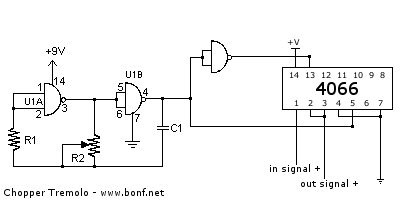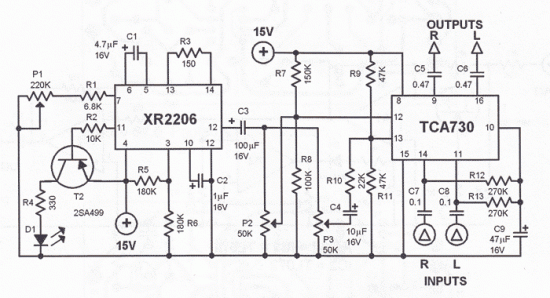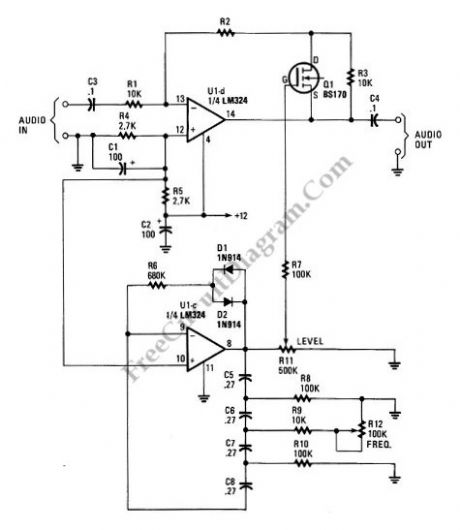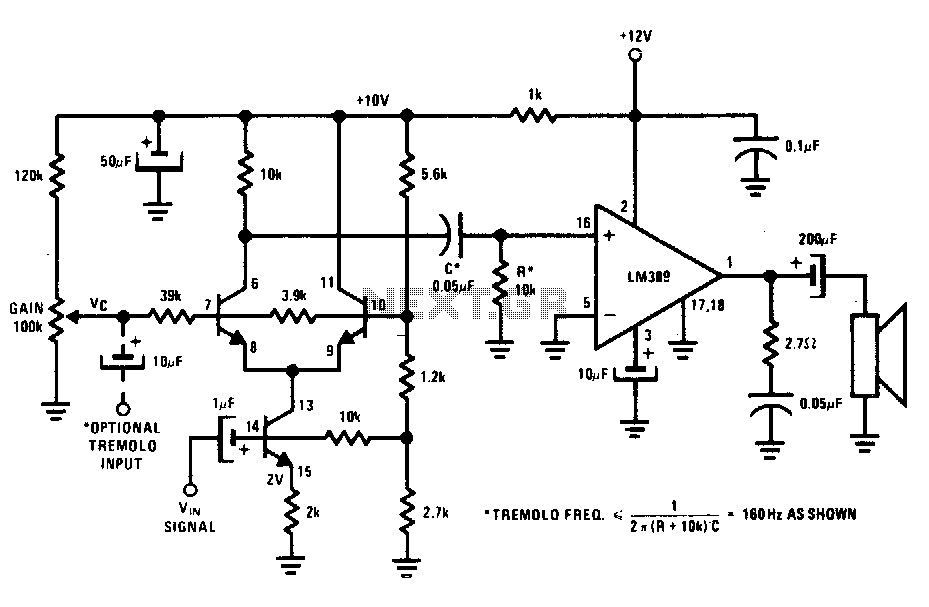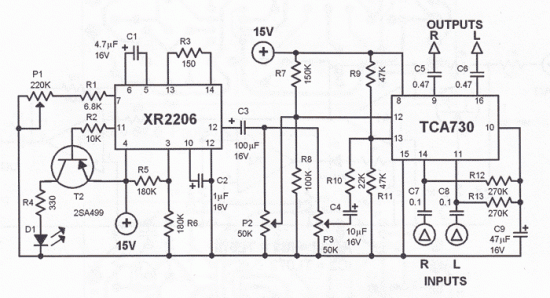
Tremolo
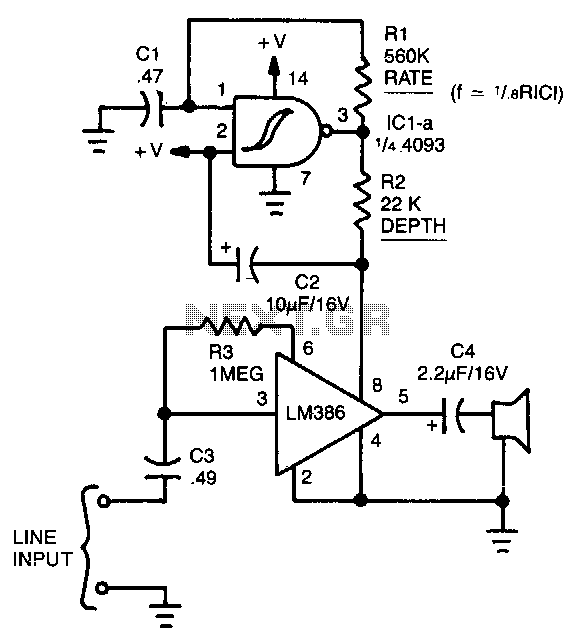
This simple circuit can color the sound coming from your audio system. Clocking for the circuit is provided by an oscillator built from one quarter of a 4093 quad NAND Schmitt trigger. With the component values shown, it will run at about 5 Hz. The clock frequency is fed to the gain control, pin 8, of an LM386 amplifier. Tremolo is produced by varying the amplifier gain. A trimmer potentiometer can be put in series with R1 to easily experiment with different rates. It is suggested to make R1 about 100 kΩ and use a 1-MΩ trimmer. This configuration allows frequencies from about 2 to 20 Hz to pass. Resistor R2 serves as the depth control, which regulates the degree of tremolo. To adjust this, a trimmer can be placed in series with R2. R2 should be a 5 kΩ resistor paired with a 50 kΩ trimmer. Since the tremolo clock utilizes the gain-control pin of the amplifier, changing the value of capacitor C4 will adjust the gain of the amplifier. Increasing C4 will raise the gain, while decreasing it will lower the gain. However, it is important not to go below 0.1 µF as this will compromise the lower frequency response.
The described circuit utilizes a 4093 quad NAND Schmitt trigger to generate a clock signal, which oscillates at approximately 5 Hz when configured with the specified component values. This clock signal is essential for modulating the gain of the LM386 audio amplifier, allowing for the creation of a tremolo effect. The tremolo effect is achieved by manipulating the gain control pin (pin 8) of the LM386, which alters the amplitude of the audio signal based on the clock frequency.
To facilitate experimentation with different modulation rates, a trimmer potentiometer can be connected in series with resistor R1. Selecting R1 as 100 kΩ and the trimmer as 1 MΩ provides a versatile range of modulation frequencies, allowing for adjustments between 2 Hz and 20 Hz. This flexibility enables the user to customize the tremolo effect to their preference.
Resistor R2 is designated as the depth control, influencing the intensity of the tremolo effect. A trimmer in series with R2 allows for fine-tuning this parameter. The suggested configuration is to use a 5 kΩ resistor for R2 along with a 50 kΩ trimmer, which provides a sufficient range for depth adjustment.
Capacitor C4 plays a critical role in determining the gain of the LM386 amplifier. By selecting a larger capacitor, the gain can be increased, which enhances the overall output level of the audio signal. Conversely, a smaller capacitor will reduce the gain. It is crucial to maintain a minimum capacitance of 0.1 µF to preserve the integrity of the lower frequency response of the audio signal, ensuring that the output remains musically relevant and does not cut off essential bass frequencies.
Overall, this circuit provides a straightforward method for introducing a tremolo effect to an audio signal, with adjustable parameters for both modulation rate and depth, making it a valuable tool for audio engineers and enthusiasts seeking to enhance their sound systems.This simple circuit can color the sound coming from your audio system. Clocking for the circuit is provided by an oscillator built from one quarter of a 4093 quad NAND Schmitt trigger. With the component values shown, it will run at about 5 Hz. The clock frequency is fed to the gain control, pin 8, of an LM386 amplifier. Tremolo is produced by varying the amplifier gain. A trimmer potentiometer can be put in series with R1, to easily experiment with different rates. 1b experiment, make R1 about 100KO and use a 1-Mil trimmer. That allows frequencies from about 2 to 20 Hz to pass. Resistor R2 is the depth control. It controls the degree of tremolo. To adjust, put a trimmer in series with R2. Make R2 a 5-KO unit and use a 50-KO trimmer. Since the tremolo clock uses the gain-control pin of the amplifier, change the value of capacitor C4 in order to change the gain of the amplifier. Make C4 larger to increase the gain or smaller to decrease it. But, don"t go any lower than 0.1 11F because you"ll be cutting into the bottom-end frequency response.
The described circuit utilizes a 4093 quad NAND Schmitt trigger to generate a clock signal, which oscillates at approximately 5 Hz when configured with the specified component values. This clock signal is essential for modulating the gain of the LM386 audio amplifier, allowing for the creation of a tremolo effect. The tremolo effect is achieved by manipulating the gain control pin (pin 8) of the LM386, which alters the amplitude of the audio signal based on the clock frequency.
To facilitate experimentation with different modulation rates, a trimmer potentiometer can be connected in series with resistor R1. Selecting R1 as 100 kΩ and the trimmer as 1 MΩ provides a versatile range of modulation frequencies, allowing for adjustments between 2 Hz and 20 Hz. This flexibility enables the user to customize the tremolo effect to their preference.
Resistor R2 is designated as the depth control, influencing the intensity of the tremolo effect. A trimmer in series with R2 allows for fine-tuning this parameter. The suggested configuration is to use a 5 kΩ resistor for R2 along with a 50 kΩ trimmer, which provides a sufficient range for depth adjustment.
Capacitor C4 plays a critical role in determining the gain of the LM386 amplifier. By selecting a larger capacitor, the gain can be increased, which enhances the overall output level of the audio signal. Conversely, a smaller capacitor will reduce the gain. It is crucial to maintain a minimum capacitance of 0.1 µF to preserve the integrity of the lower frequency response of the audio signal, ensuring that the output remains musically relevant and does not cut off essential bass frequencies.
Overall, this circuit provides a straightforward method for introducing a tremolo effect to an audio signal, with adjustable parameters for both modulation rate and depth, making it a valuable tool for audio engineers and enthusiasts seeking to enhance their sound systems.This simple circuit can color the sound coming from your audio system. Clocking for the circuit is provided by an oscillator built from one quarter of a 4093 quad NAND Schmitt trigger. With the component values shown, it will run at about 5 Hz. The clock frequency is fed to the gain control, pin 8, of an LM386 amplifier. Tremolo is produced by varying the amplifier gain. A trimmer potentiometer can be put in series with R1, to easily experiment with different rates. 1b experiment, make R1 about 100KO and use a 1-Mil trimmer. That allows frequencies from about 2 to 20 Hz to pass. Resistor R2 is the depth control. It controls the degree of tremolo. To adjust, put a trimmer in series with R2. Make R2 a 5-KO unit and use a 50-KO trimmer. Since the tremolo clock uses the gain-control pin of the amplifier, change the value of capacitor C4 in order to change the gain of the amplifier. Make C4 larger to increase the gain or smaller to decrease it. But, don"t go any lower than 0.1 11F because you"ll be cutting into the bottom-end frequency response.
